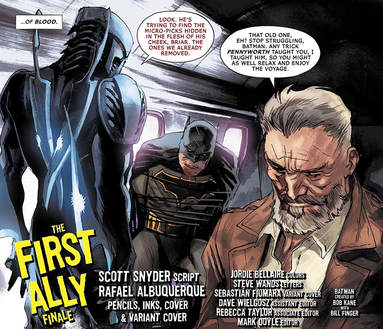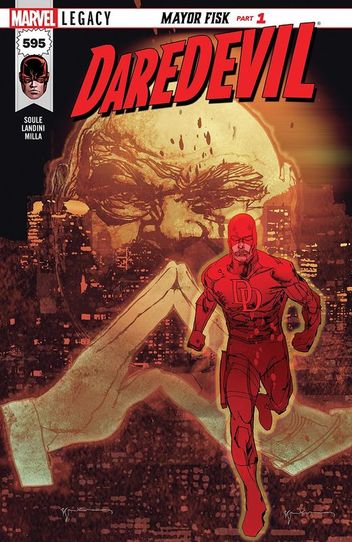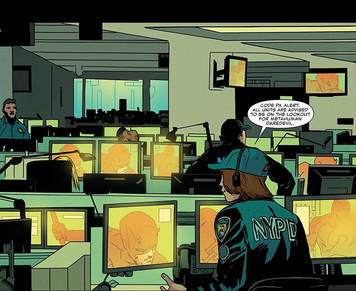Written by Joel T. Lewis I can’t quite explain to you, dear reader, why it’s taken me so long to write my final review for Scott Snyder’s All-Star Batman series. Perhaps I was disappointed that it didn’t quite stick the landing for me, maybe I grew to begrudge Snyder’s panel choking dialogue, exposition, and narration, but I think if I’m really honest with myself it’s because I was so sad to see it go so soon. Tom King is writing an exceptional Batman, and I believe that his tenure on the flagship title (‘The War of Jokes’ and ‘Riddles’ arcs especially) will go down in history as one of the most important periods in Batman’s history, but no Batman run that I’ve ever read has been as fun as All-Star Batman. All-Star Batman was a slightly lighter Dark Knight, and what a breath of fresh air that was. He quipped, he smiled, and you really got the sense that for this Bruce Wayne his mission wasn’t just a burden he’d taken on to keep his promise to his parents, it was something he was good at, it was something he loved to do. Pirates, Ice-Zombies, Snyder even gave us Shark repellent. And while the dramatic conclusion of this swashbuckling pirate arc ‘The First Ally’ fell a little flat for me with the revelation that the man behind the Black Knight was an Alfred clone and Snyder beating the Pirate story analog to death, this arc and its conclusion was a lot of fun and had a hell of a lot of heart. Snyder thoroughly explores the power and familial dynamics of the father-son relationship through the multigenerational pairings that he’s set up over the course of this final arc. The tension between Alfred and Briar, who’s possessive and manipulative influence on Alfred is in direct and extreme contrast to the aloofness of Alfred’s actual father culminates in Alfred’s violent rejection of Briar’s Black Knight mantle. This rejection by a promising pupil, and in a very real sense, a surrogate son, drives Briar to create an imperfect clone of Pennyworth whose own father-son relationship with Briar is even more unhealthy. Constantly compared with and never living up to the original Alfred, the clone, turns on Briar in a last-minute epiphany which, funnily enough, fulfills Briar’s own twisted hopes for Alfred. By killing Briar, the Black Knight rejects and frees himself from the only familial attachment he had (however traumatic an influence that attachment was). This was the key to becoming Britain’s purest servant, the Black Knight, at least as far as Briar was concerned, and his second surrogate son surprised him by fulfilling that criteria.  Snyder also gives Alfred closure as he discovers a stack of letters addressed to him but were never sent by his real father Jarvis at the same moment he is introduced to Bruce Wayne for the first time. This cycle of father-son dysfunction and equalization is skillfully executed and adds yet another layer of intimacy to the Bat-Family dynamic. One that, in my opinion, was a long time coming. The love and understanding conveyed in that final embrace as Bruce and Alfred stand in the shadow of the Batcave is completely earned and really satisfying as a devoted reader and fan of Batman. While juggling these intricate and complex paternal dynamics, Snyder manages to pepper in some of the best lines Alfred has ever spoken. I loved, ‘Ahoy @#$%! I got your Tea right here!’ in particular as Alfred swoops in via biplane to respond to Briar’s comment amount the domestic turn Pennyworth’s life has taken. But there’s one line in particular that hammers home Snyder’s understanding of the power of the Batman narrative in popular culture and shows his skill when wielding it. Sitting behind a bristling biplane-mounted machine gun Alfred tells his former mentor, “Well, there’s a saying in this country, Briar. ‘Always be yourself. Unless you can be Batman.’ But sadly, I can never be Batman. Because Batman doesn’t use guns.” Never in my life would I have thought I would get to hear the words of a meme of all things come out of Alfred Pennyworth’s mouth. It was glorious and it shows again how comfortable Snyder is writing Batman. He knows that character, he knows the character’s fans, and knows how to balance fan service and serious content. I loved All-Star Batman, not because every issue landed for me, or because it’s the purest representation of the Dark Knight, it’s because it’s featured the Batman who’s had the most fun and I’m going to miss it. Until next time, Geek On!
0 Comments
Written by Zeke Perez Jr. I typically tend to review a comic series after it is released in its entirety, rather than on an issue-by-issue basis. But every now and then, an issue or story arc comes along and I just can’t wait. I want to tell the world about it right off the bat. Enter the ‘Mayor Fisk’ arc in the current Daredevil run (beginning with Marvel Legacy’s Daredevil #595). Recent Daredevil comics have been grounded in reality-driven storylines, as the lives of superheroes intertwine with human politics. The preceding - and equally wonderful - ‘Supreme’ arc follows Matt Murdock as he argues a Supreme Court case that legitimizes the role of superheroes in the legal system, allowing them to act as more than vigilantes by granting them the ability to appear and testify in court. In ‘Supreme’, ‘The Kingpin’ Wilson Fisk attempts to have Murdock taken down in court by a competing lawyer and out of court by an assassin. Now, the ‘Mayor Fisk’ arc builds on that as Fisk attempts to turn the entire system against Daredevil. The shift to Fisk as Mayor is sudden. In fact, you learn that Fisk was elected within the first couple pages of the issue. Murdock suspects foul play and corruption, immediately going to work to challenge the election results and to preserve the legal winnings he achieved in ‘Supreme’. Meanwhile, Fisk has turned the city’s police force against Daredevil and seeks to turn the populace against him too. Fisk claims that he and the people of New York want to take a stand against Daredevil and the other heroes that are ‘invading their lives, destroying their property, bringing chaos and terror’. The issue concludes as the two face off with Fisk promising to use everything in his power as mayor to stop Daredevil, and Daredevil hoping to take that very power away.  Heroes vs. civilians has risen as a central theme in plenty of media. Batman v. Superman: Dawn of Justice, Captain America: Civil War and the Civil War comics, and many others touch on it. I would argue that few have presented this battle better than writer Charles Soule has in both ‘Supreme’ and the first issue of ‘Mayor Fisk’. Soule leans on real-life issues to create gritty stories that feel genuine, interesting, and exciting. While court cases and municipal elections might not immediately come to mind when thinking of a superhero story, Soule’s writing produces deep and riveting plots that rival any action-centric comic. Artist Stefano Landini and color artist Matt Milla do a fantastic job illustrating the comic. Daredevil and the Hell’s Kitchen landscape both have a very classic feel to them. Additionally, they’ve done an exceptional job portraying Fisk himself. In other depictions, Fisk has looked bulky or abnormally big. The Kingpin of the ‘Mayor Fisk’ arc looks powerful yet human, his facial expressions giving him a chilling edge. It is one of the best depictions of Kingpin that I’ve seen. Daredevil #596 - the second issue of the ‘Mayor Fisk’ arc - comes out today. It’s not too late to jump into this storyline. The arc will run for five issues total, concluding in February. If you want catch Fisk’s mayoral term on the front-end, head to your local comic book shop today. Happy New Comic Book Day! |
Archives
May 2024
|
|
© 2012-2025, Nerds That Geek LLC.
All Rights Reserved. |
uWeb Hosting by FatCow
